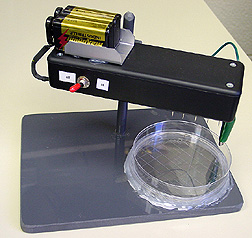This page has been archived and is being provided for reference purposes only. The page is no longer being updated, and therefore, links on the page may be invalid.
Read the magazine story to find out more. |
|
Low-Cost Air Sampler Could Help Poultry Farmers
By Sharon DurhamOctober 14, 2005
Dust may only be a nuisance to a homeowner, but for a poultry grower it can be a disaster. On those dust particles organisms such as Salmonella and E. coli can hitch a ride and wreak havoc in a poultry house or layer room.
To deal with this problem, a low-cost, simple, portable electrostatic sampling device was developed by Agricultural Research Service (ARS) scientists at the Southeast Poultry Research Laboratory in Athens, Ga. The device takes samples of airborne bacteria, viruses and spores that can be problematic in poultry houses and layer rooms.
The compact, two-pound device developed by agricultural engineer Bailey Mitchell and his colleagues is battery-operated and housed in a completely waterproof enclosure, allowing complete disinfection after use in highly infectious areas.
The device has good potential as an affordable and efficient sampling method for detecting pathogenic strains of microorganisms that may be present in numbers so small it is difficult to recover them by traditional methods. Airborne particles are electrostatically charged, which makes them attracted to grounded surfaces--in this case, a metal plate or an agar dish.
The device pulls in air, along with dust particles, for sampling. It’s been tested extensively in clean lab areas, in exhaust air from poultry houses, and in caged layer rooms with birds infected with Salmonella enteritidis. It has shown up to a 20-fold improvement compared to standard settling plate sampling techniques.
Previous devices with good-to-high efficiency recovery were typically large and bulky, difficult to disinfect, or expensive, ranging from $1,000 to $25,000 in price. According to Mitchell, this unit has about $50 worth of parts.
Performance tests suggest the electrostatic sampling device, if operated for two hours or more, can provide the equivalent of a High Volume Air Sampler. The device has a patent pending and is available for licensing.
Read more about the research in the October 2005 issue of Agricultural Research magazine.
ARS is the U.S. Department of Agriculture’s chief in-house scientific research agency.


